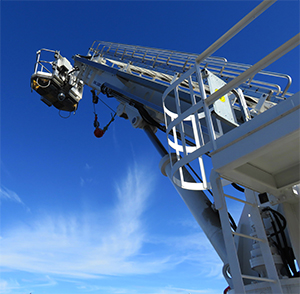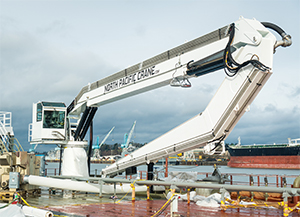Deck cranes have come a long way from the jury-rigged, block-and-tackle affairs operated by man-powered capstans in the age of sail. Gone, too, for the most part are the huffing donkey engines of an earlier age.
Today’s deck cranes combine the latest in hydraulics, cabling and electronics to deliver strength and deftness unachievable in times past. And they are being developed, sometimes even custom-built, to serve very specific needs.
It is a market with many players, including MacGregor, Rapp Marine, North Pacific Crane Co. (NPCC), Palfinger Marine and Hawboldt Industries. Across that vendor landscape, several trends have recently appeared.
Among those trends is more attention to fire hazards, said Reed Okawa, business development manager for marine cranes at Hawboldt Industries in Chester, Nova Scotia. For instance, in markets where liquefied natural gas (LNG) is becoming a more common fuel, or where LNG transfers are part of business, manufacturers are adopting explosion-proof motors, non-sparking cables and non-sparking hubs.
 |
|
The Port of Long Beach’s new fireboats, Protector and Vigilance, are each equipped with a 50-foot custom crane from Rapp Marine. The personnel basket levels automatically as the boom is extended. The boom can be controlled from the basket, from the base of the crane or remotely. |
|
Courtesy Rapp Marine |
“We work in the offshore market, and there the trend is that cranes are tending to get bigger and incorporate capabilities like heave compensation and lighter synthetic ropes,” Okawa said.
That specific capability, usually leveraging advanced fibers, takes advantage of the neutral buoyancy (or near-neutral buoyancy) of those materials to effectively eliminate the weight of the cable itself from lifting calculations, a vital issue when equipment is being lowered thousands of feet to the seabed. Okawa said there also seems to be more demand in the research market in general.
MacGregor, a subsidiary of Helsinki-based Cargotec, is another company involved in the deck crane market globally and actively evolving its product line. According to senior communications manager Heli Malkavaara, MacGregor solutions are designed to perform with the sea, including handling huge swells, shallow waters and extreme temperature ranges.
The MacGregor three-axis motion-compensated crane is one of the advanced products. The technology, for telescoping or knuckle-boom models, can provide accurate load positioning during offshore wind turbine, rig supply and maintenance operations, whether the structures are fixed or floating.
 |
|
MacGregor’s Triplex net cranes, built primarily for net stacking, are designed to make sure the transport roller is always in the proper working position. The broad links provide stability, especially when the crane is carrying a load sideways with the arms fully extended. |
|
Courtesy MacGregor |
Malkavaara explained that the multidimensional compensation technology adjusts for a vessel’s horizontal movements (pitch and roll) as well as changes along the vertical axis by using real-time sensors and an advanced control system.
“Standard active heave compensation (AHC) technology uses the crane’s winch to compensate for all vertical movements,” Malkavaara said. The three-axis compensation technology helps ensure that the crane can securely keep a suspended load in a fixed position, even in rough seas.
Malkavaara said the crane also can be used for non-compensated general lifting and ship-to-ship operations, and it is certified for personnel lifts with a specially-designed basket.
MacGregor is also testing the waters with its first fiber-rope offshore crane, called FibreTrac. According to Malkavaara, it is entering the final stages of production and is expected to be ready for introduction to the market later in the year. It was developed through a cooperative agreement combining MacGregor’s crane technology with the fiber-rope tensioning technology provided by Parkburn Precision Handling Systems of the United Kingdom.
 |
|
Palfinger’s model PK 50002 M knuckle-boom crane has a working-load capacity of more than 26,000 pounds. The crane’s geometry, compact design and foldable boom allow it to be deployed on vessels where space is limited. |
|
Courtesy Palfinger Marine |
MacGregor’s Triplex brand, used primarily for fishery net hauling, offshore anchor handling and oceanographic systems, is another major slice of the company’s product line. Triplex enables fishermen to fish faster, safer and with fewer crewmembers on board, Malkavaara said. For oceanographic research vessels, the Triplex product portfolio includes a variety of A-frame systems, CTD (conductivity, temperature and depth) handling systems including davits and overhead cranes, and coring systems. Since every vessel is uniquely designed for specific research operations, each Triplex handling system is custom-designed to fit the respective ship configuration, she said.
MacGregor and ESL Shipping Oy of Helsinki, Finland, also have agreed to jointly develop and test an autonomous discharging feature on MacGregor bulk handling cranes, Malkavaara said. The idea is that autonomous operation can potentially improve efficiency and safety, with discharging monitored and controlled from the bridge — therefore eliminating the need for personnel to operate in hazardous areas.
At Rapp Marine, which has been building and servicing cranes for more than a decade from its Seattle location, a big focus is on custom-designed products, said sales and marketing manager Fin Moore. Rapp Marine originally operated under the Hydra Pro name and became affiliated with MacGregor this year.
Rapp’s recent deliveries include a pair of custom cranes designed for two new fireboats at the Port of Long Beach, Calif. The 50-foot-long cranes resemble telescopic boom lifts with a self-leveling function, meaning the personnel basket automatically levels as the crane is extended upward. The basket has a manual control override, can slew side to side up to 30 degrees, and can be accessed via aluminum ladder on top of the boom. The boom can be controlled from the personnel basket, the operator control station at the base of the crane, or by using a wireless belly pack.
 |
|
North Pacific Crane Co., formerly known as Alaska Marine Crane, has delivered eight 95-foot-long knuckle-boom cranes during the past year for offshore service. The cranes are installed on 114,000-barrel oil response barges. |
|
Courtesy North Pacific Crane Co. |
Rapp cranes also have been integrated to reduce ships’ operating costs — and their carbon footprint — while pierside. “The Port of LA uses a unique power system that delivers shoreside power to vessels while docked. … Therefore, the operators do not have to burn diesel fuel while they’re in port,” Moore said. A Rapp double telescopic crane handles power cables and extends the connections out to the vessels, he explained.
North Pacific Crane Co., which was founded in 2004, has roots that go back to 1978 when it was called Alaska Marine Crane. The company designs and manufactures a range of offshore and dock cranes, and has produced more than 2,000 to date. Capabilities include fixed boom, telescopic, knuckle boom and knuckle-telescopic boom cranes, according to the company.
As the industry evolves and expands, the winner for most visible new application must surely go to Palfinger Marine, which has been celebrating the adoption of one of its lightweight knuckle-boom cranes by Sig Hansen, the captain of F/V Northwestern and mainstay on the Discovery Channel’s Deadliest Catch.
 |
|
For vessels where the demand for load capacity doesn’t exceed 3,500 pounds, Palfinger offers the PK 6500 M knuckle-boom crane. The deck unit is light but still packs plenty of punch with the optimum ratio of lifting power to deadweight, according to the manufacturer. |
|
Courtesy Palfinger Marine |
Cranes are extremely important on crab-fishing boats, of course. F/V Northwestern can carry up to 250 pots, which are handled by the crane day and night with very few interruptions. According to Palfinger, the low weight of the crane was one of the main selling points since the lighter the crane is, the more stable the vessel can be.
At Hawboldt, where standard and custom designs are offered, some of the available leading-edge features typify where the industry is heading: remote control, walk-around and fixed control options; load-moment indicator systems; hazardous zone ratings for NEC, IEC and ATEX electrical codes; overload alarms, and more.
“The fact is that every market is different, so there is a great diversity of capabilities available,” Okawa said.

